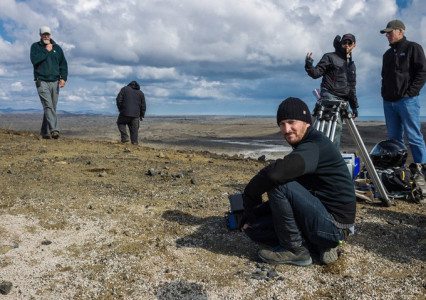‘Noah’ Features The Most Complicated Effects Shot In ILM’s History
9 Oct2013
By Saul Sudin

No upcoming film is more anticipated here at Jewish Art Now than director Darren Aronofsky’s take on the events of Noah and the flood, simply titled ‘Noah‘. Past projects like Pi and The Fountain have shown the filmmaker has no fear tackling exciting experimental takes on Judaism and spirituality and for almost three years we have been following the development of this film from page to page to production.
Having completed production in New York and Iceland, Noah is now in post-production in advance of its theatrical release this spring. Aronofsky told the Directors Guild of America that the film will feature the most complicated shot in the history of Industrial Light and Magic, the visual effects company that George Lucas established in 1975 to make Star Wars. Since their inception, ILM have been at the forefront of effects both practical and digital, being instrumental in producing complicated effects for everything from Who Framed Roger Rabbit? to Terminator 2: Judgement Day and Jurassic Park.
“I don’t think it’s the most incredible shot, but I think because of all the hair on the animals it was incredibly complicated for them. They said, ‘We can only render it two or three more times so make sure those are exactly right because they take so long and are so complex.’†he told the DGA. All the animals in the film will be digitally inserted, much like the tiger in Ang Lee’s brilliant Life of Pi. Aronofsky added, “Politically it’s not a great thing to work with live animals and that’s becoming more apparent to people as time goes by, but also, technically, it would have been extremely difficult. And we’ve learned from lots of other films how hard it is to bring different kinds of animals together.†(As in clashing species or animals that might decide to eat their co-stars.)

Getting into the science of biblical texts has forced the director to rethink the animals and their ark. “All the animals in the movie are slightly tweaked; I didn’t want the clichéd polar bear, elephant, and lion walking onto the Ark; I didn’t want the shot of a giraffe’s head looking over the rail. I wanted to respect the storyline and think what would have been involved if it all really happened. We basically went through the animal kingdom and pinpointed the body types we wanted: some pachyderms, some rodents, reptiles, and the bird kingdom. We chose the species and they were brought to life with different furs and colors. We didn’t want anything fully recognizable but not completely absurd either.â€
Regarding the ark itself, which was a full scale set, “There are lots of different kinds of cubits…There’s an Egyptian cubit, a Roman cubit, a Hebrew cubit. We got a general sense of what the cubit is and we were pretty spot on to the measurements and the descriptions in the Bible of what the Ark looked like—75 feet-by-55 feet-by-450 feet, something like that. But don’t quote me.â€
The accuracy of the film to the text, as well as Rabbinic and Midrashic sources has yet to be seen, but one thing is certain; this film is ambitious.
- In: News
- Tags: Art as Midrash, Digital Art, Film




